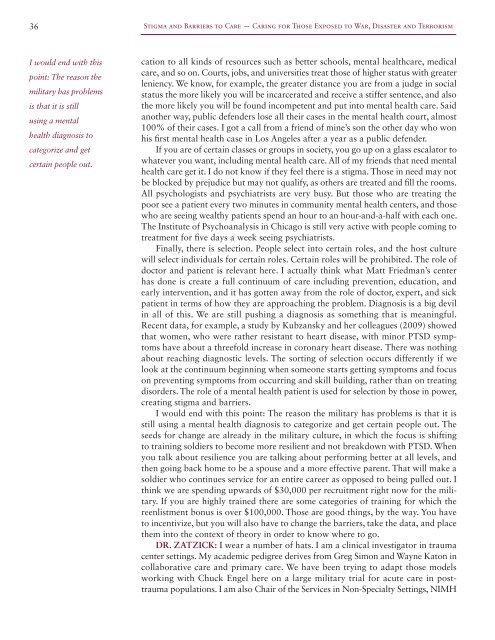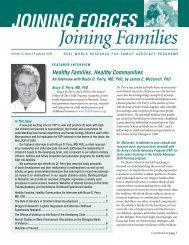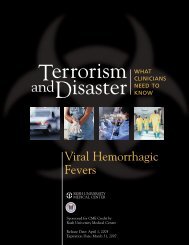stigma and barriers to care - Uniformed Services University of the ...
stigma and barriers to care - Uniformed Services University of the ...
stigma and barriers to care - Uniformed Services University of the ...
Create successful ePaper yourself
Turn your PDF publications into a flip-book with our unique Google optimized e-Paper software.
36<br />
Stigma <strong>and</strong> Barriers <strong>to</strong> Care — Caring for Those Exposed <strong>to</strong> War, Disaster <strong>and</strong> Terrorism<br />
I would end with this<br />
point: The reason <strong>the</strong><br />
military has problems<br />
is that it is still<br />
using a mental<br />
health diagnosis <strong>to</strong><br />
categorize <strong>and</strong> get<br />
certain people out.<br />
cation <strong>to</strong> all kinds <strong>of</strong> resources such as better schools, mental health<strong>care</strong>, medical<br />
<strong>care</strong>, <strong>and</strong> so on. Courts, jobs, <strong>and</strong> universities treat those <strong>of</strong> higher status with greater<br />
leniency. We know, for example, <strong>the</strong> greater distance you are from a judge in social<br />
status <strong>the</strong> more likely you will be incarcerated <strong>and</strong> receive a stiffer sentence, <strong>and</strong> also<br />
<strong>the</strong> more likely you will be found incompetent <strong>and</strong> put in<strong>to</strong> mental health <strong>care</strong>. Said<br />
ano<strong>the</strong>r way, public defenders lose all <strong>the</strong>ir cases in <strong>the</strong> mental health court, almost<br />
100% <strong>of</strong> <strong>the</strong>ir cases. I got a call from a friend <strong>of</strong> mine’s son <strong>the</strong> o<strong>the</strong>r day who won<br />
his first mental health case in Los Angeles after a year as a public defender.<br />
If you are <strong>of</strong> certain classes or groups in society, you go up on a glass escala<strong>to</strong>r <strong>to</strong><br />
whatever you want, including mental health <strong>care</strong>. All <strong>of</strong> my friends that need mental<br />
health <strong>care</strong> get it. I do not know if <strong>the</strong>y feel <strong>the</strong>re is a <strong>stigma</strong>. Those in need may not<br />
be blocked by prejudice but may not qualify, as o<strong>the</strong>rs are treated <strong>and</strong> fill <strong>the</strong> rooms.<br />
All psychologists <strong>and</strong> psychiatrists are very busy. But those who are treating <strong>the</strong><br />
poor see a patient every two minutes in community mental health centers, <strong>and</strong> those<br />
who are seeing wealthy patients spend an hour <strong>to</strong> an hour-<strong>and</strong>-a-half with each one.<br />
The Institute <strong>of</strong> Psychoanalysis in Chicago is still very active with people coming <strong>to</strong><br />
treatment for five days a week seeing psychiatrists.<br />
Finally, <strong>the</strong>re is selection. People select in<strong>to</strong> certain roles, <strong>and</strong> <strong>the</strong> host culture<br />
will select individuals for certain roles. Certain roles will be prohibited. The role <strong>of</strong><br />
doc<strong>to</strong>r <strong>and</strong> patient is relevant here. I actually think what Matt Friedman’s center<br />
has done is create a full continuum <strong>of</strong> <strong>care</strong> including prevention, education, <strong>and</strong><br />
early intervention, <strong>and</strong> it has gotten away from <strong>the</strong> role <strong>of</strong> doc<strong>to</strong>r, expert, <strong>and</strong> sick<br />
patient in terms <strong>of</strong> how <strong>the</strong>y are approaching <strong>the</strong> problem. Diagnosis is a big devil<br />
in all <strong>of</strong> this. We are still pushing a diagnosis as something that is meaningful.<br />
Recent data, for example, a study by Kubzansky <strong>and</strong> her colleagues (2009) showed<br />
that women, who were ra<strong>the</strong>r resistant <strong>to</strong> heart disease, with minor PTSD symp<strong>to</strong>ms<br />
have about a threefold increase in coronary heart disease. There was nothing<br />
about reaching diagnostic levels. The sorting <strong>of</strong> selection occurs differently if we<br />
look at <strong>the</strong> continuum beginning when someone starts getting symp<strong>to</strong>ms <strong>and</strong> focus<br />
on preventing symp<strong>to</strong>ms from occurring <strong>and</strong> skill building, ra<strong>the</strong>r than on treating<br />
disorders. The role <strong>of</strong> a mental health patient is used for selection by those in power,<br />
creating <strong>stigma</strong> <strong>and</strong> <strong>barriers</strong>.<br />
I would end with this point: The reason <strong>the</strong> military has problems is that it is<br />
still using a mental health diagnosis <strong>to</strong> categorize <strong>and</strong> get certain people out. The<br />
seeds for change are already in <strong>the</strong> military culture, in which <strong>the</strong> focus is shifting<br />
<strong>to</strong> training soldiers <strong>to</strong> become more resilient <strong>and</strong> not breakdown with PTSD. When<br />
you talk about resilience you are talking about performing better at all levels, <strong>and</strong><br />
<strong>the</strong>n going back home <strong>to</strong> be a spouse <strong>and</strong> a more effective parent. That will make a<br />
soldier who continues service for an entire <strong>care</strong>er as opposed <strong>to</strong> being pulled out. I<br />
think we are spending upwards <strong>of</strong> $30,000 per recruitment right now for <strong>the</strong> military.<br />
If you are highly trained <strong>the</strong>re are some categories <strong>of</strong> training for which <strong>the</strong><br />
reenlistment bonus is over $100,000. Those are good things, by <strong>the</strong> way. You have<br />
<strong>to</strong> incentivize, but you will also have <strong>to</strong> change <strong>the</strong> <strong>barriers</strong>, take <strong>the</strong> data, <strong>and</strong> place<br />
<strong>the</strong>m in<strong>to</strong> <strong>the</strong> context <strong>of</strong> <strong>the</strong>ory in order <strong>to</strong> know where <strong>to</strong> go.<br />
DR. ZATZICK: I wear a number <strong>of</strong> hats. I am a clinical investiga<strong>to</strong>r in trauma<br />
center settings. My academic pedigree derives from Greg Simon <strong>and</strong> Wayne Ka<strong>to</strong>n in<br />
collaborative <strong>care</strong> <strong>and</strong> primary <strong>care</strong>. We have been trying <strong>to</strong> adapt those models<br />
working with Chuck Engel here on a large military trial for acute <strong>care</strong> in posttrauma<br />
populations. I am also Chair <strong>of</strong> <strong>the</strong> <strong>Services</strong> in Non-Specialty Settings, NIMH




